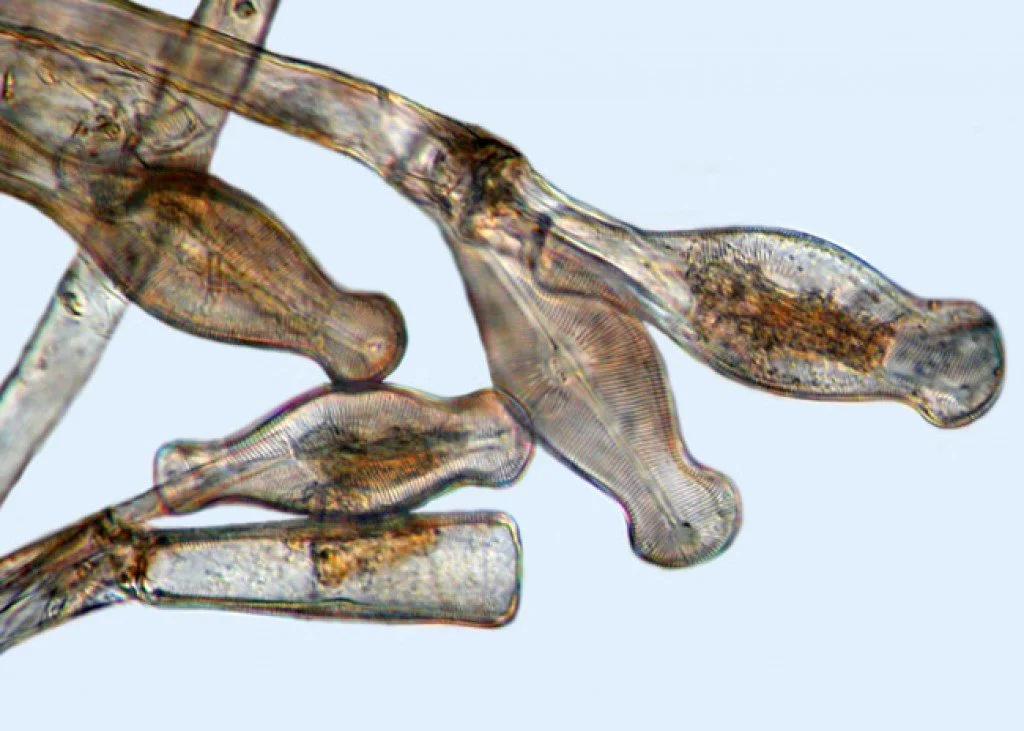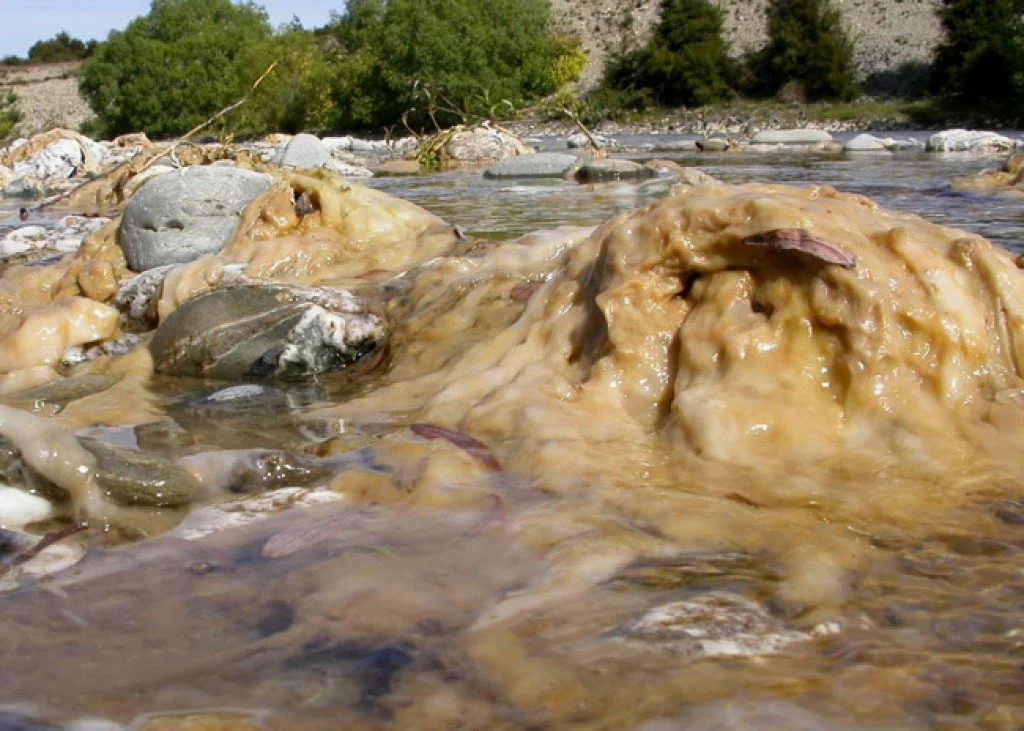Project Aim: To develop a novel way to control invasive pest species such as didymo, using targeted interfering RNA.
The days of using indiscriminate pesticides or herbicides to control pest species are largely behind us. The future will include a range of targeted, species-specific tools 1. One such technique is interfering RNA. This is already being used in medicine 2 and for insect pest control 1 and more recently to control fungi such as that responsible for Myrtle rust 3. This project aims to adapt existing technology for use in an aquatic setting to control didymo. If successful, this could be a blueprint for controlling other aquatic invasive or pest species in Aotearoa New Zealand and globally.
Introduction to Didymo (Didymosphenia geminata)
Didymo (Didymosphenia geminata) is an invasive alga that was likely accidentally introduced to Aotearoa New Zealand at the turn of the 21st Century on the footwear of a tourist from North America. It has led to infestations in over 200 distinct South Island waterways but to date didymo has not affected North Island rivers for reasons that are not fully understood. Didymo produces thick polysaccharide mats up to 20 cm thick that smoother riverbeds. This layer of ‘rock snot’ can suffocate the ecology of the river whilst also reducing the river to what could be described as an unsightly brown sewer. The mats are not sufficiently grazed or controlled by any native species and only extreme flood events dislodge it and wash it away downstream. To date, all previous efforts to control didymo have been largely unsuccessful. Interestingly, when didymo is in a ‘happy’ state it replicates but goes relatively unnoticed in the river. However, when it becomes ‘unhappy’, e.g. due to suboptimal water chemistry, it channels all its energy into producing the ‘rock snot’. This means that there are already molecular switches within didymo that can switch off the ‘rock snot’ production.
The impacts and costs of didymo on Aotearoa New Zealand
Ecological: didymo severely harms the river ecology, reducing the diversity and health of the pre-existing species, including invertebrates, fish and birds 4 5.
Tourism and recreation: a river that looks like a sewer is a major blot on the Aotearoa New Zealand tourism landscape. Taonga treasures such as trout fishing (that was previously world-class) and tramping are being increasingly damaged, and tourism spend will be reducing as a consequence 6.
Irrigation and agriculture: didymo can block filters and damage pumps involved in irrigation systems having a negative impact on the agriculture industry. A recent survey of Irrigation NZ members found the didymo issue was very dependent on location (i.e. severity of river infestation). For a small number of irrigators it was an extreme problem – average severity score of 25/100, ranging from no problem to extremely bad problem 7. The current financial cost to Aotearoa New Zealand is difficult to gauge, involving time required to keep the systems clean of didymo, the time diverted from other task and the cost of the potential loss of crop, but across the South Island could easily be millions of dollars.
Hydroelectric power: didymo can block water inlets and damage hydroelectric turbines, increasing the cost of generation and affect continuity of power production, so affecting all industries in Aotearoa New Zealand. One example is from the Manapouri power station which is now required to discharge water into Doubtful Sound to flush the didymo out of the system 8. This water is lost to power generation and so is a major loss of electricity (1 to 2.5 GWh per flush), putting the price of generation up and being an opportunity cost to Aotearoa New Zealand. Again, it is difficult to put a dollar price on the cost of didymo to the electricity industry but across all the generating companies is likely to be in the millions of dollars.
The costs of pests to New Zealand - the bigger picture
There is a pressing need to develop a control for didymo that is safe and specific, which is what this project aims to achieve. However, the bigger picture is that if this project is successful, then it could be a blueprint technique for the control of other invasive species. The total economic cost of pests to the primary sector in Aotearoa New Zealand is estimated to be almost $6 billion in the 2019-20 financial year. Of the $6 billion estimate, defensive costs represent almost $1.7 billion and production losses $4.3 billion 9. Other aquatic pests, such as Lake Snow (Lindavia intermedia) or even Gold Clams (Corbicula fluminea) could be specifically controlled using the same technique that we are proposing. Future new incursions could also potentially be controlled or eradicated in the same way. This could represent billions of dollars of advantage and financial saving for Aotearoa New Zealand
Didymosphenia on mucilaginous stalks, X200. Photo: Manaaki Whenua
The invasive diatom Didymosphenia. Courtesy of Landcare Research
About this programme - Interfering RNA - a beginner’s guide
Whilst DNA is the source code for most living organisms, RNA is the method by which this code is read and translated into action. If DNA is the recipe book, then RNA is the photocopy of one page, and reading the one recipe results in a dish being served (e.g. the production of the particular protein that performs a function, such as an enzyme that manufactures ‘rock snot’). RNA is made up of four base molecules, and these molecules have a pairing molecule that they seek to bind to. This means that if there is a single-stranded string of RNA code, when the mirror-image string of code is presented, then these two strings will strongly bind together (become double-stranded) and this will block the RNA from functioning. Only the exact mirror-image RNA will bind. Therefore, if you know the particular RNA code that you want to block, you can make the specific RNA that will bind and block it, that will not block any other RNA code. This means that the blocking mechanism can be highly specific for a single RNA molecule and allows for an extremely high degree of target accuracy. This is not just species specific, but molecule specific, which is a huge advantage when trying to develop a targeting control mechanism that won’t stray off-target. This project aims to switch off ‘rock snot’ production within didymo using interfering RNA and return it to its ‘happy’ and harmless state.
Our programme plan:
As part of preliminary work we will be engaging with iwi and conservation partners to make sure we have the partnership and on-going involvement required for this project to succeed. This includes not just permission to collect and work on Didymo, but the wider social license to operate.
1) Identify key genes in didymo that are involved in producing ‘rock snot’ and the corresponding RNA codes involved. This involves collected didymo from multiple locations around Aotearoa New Zealand sequencing parts of their genomes.
2) Make RNA strands that will bind to and interfere with the ‘rock snot’ RNA, and see whether these can switch off ‘rock snot’ production in a laboratory setting.
3) Identify ways to deliver the interfering RNA into didymo. Using existing didymo viruses to deliver the RNA may be one approach. We aim to identify existing didymo viruses and explore whether they can be used as a delivery mechanism.
If we can develop the interfering RNA strands that are specific only to the target molecules that only occur in didymo (e.g. the key rocksnot-producing steps), and find a way to deliver these RNA strands into didymo, then once any risks have been identified and mitigated, we would then propose a programme of field trials, with permission and oversight of all appropriate iwi, stakeholders and regulatory bodies including MPI and Biosecurity New Zealand. It may be that a control mechanism that targets a number of didymo processes in Year 1, which is then rotated to a different set of enzyme targets in Year 2 in a rolling process over a number of years may be a good strategy to reduce the chance of Didymo developing resistance, and also to establish which targets are most effective.
If successful, then the field trials could be extended across the South Island and hopefully return Aotearoa New Zealand rivers back to their previous condition, and reverse the harm done to our ecology, recreation, tourism, agriculture and energy production.
We see this implementation programme after initial field trials as beyond the scope of this research project and more in the realm of MPI, Biosecurity New Zealand and Government. If that was a successful roll out, and controlled didymo with no unintended consequences, then this process could be a blueprint for controlling other invasive or pest aquatic species in Aotearoa New Zealand and globally.
If you might be interested in helping, please have a look at our Support page.
References
1. Stokstad E. The perfect pesticide? Science 2024;384(6703):1398-401. doi: 10.1126/science.adr2991 [published Online First: 20240627]
2. Traber GM, Yu AM. RNAi-Based Therapeutics and Novel RNA Bioengineering Technologies. J Pharmacol Exp Ther 2023;384(1):133-54. doi: 10.1124/jpet.122.001234 [published Online First: 20220609]
3. Degnan RM, McTaggart AR, Shuey LS, et al. Exogenous double-stranded RNA inhibits the infection physiology of rust fungi to reduce symptoms in planta. Mol Plant Pathol 2023;24(3):191-207. doi: 10.1111/mpp.13286 [published Online First: 20221217]
4. Bray J, Kilroy C, Gerbeaux P, et al. Ecological processes mediate the effects of the invasive bloom-forming diatom Didymosphenia geminata on stream algal and invertebrate assemblages. Hydrobiologia 2020;847(1):177-90.
5. Gärdes A. IMH, Grossart H.-P., Passow U. Didymo and other freshwater pests: Economic Impact Assessment. Prepared for Ministry of Agriculture and Fisheries. 36 pp.Available from: http://www.biosecurity. govt.nz/files/pests/didymo/didymo-and-other-freshwater-pests-eia-aug2011.pdf [Accessed 01 August 2013]. 2011
6. Bell C. Personal communication - comment from trout fishing guide. In: Cawood T., 2025.
7. Adams N. Personal communication - survey of Irrigation NZ members. Survey of Irrigation NZ members, 2025.
8. Personal communication - cost of didymo to Meridian Energy. Discussion of costs to Meridian Energy of didymo, 2025.
9. Industries N-BAPfMfP. Economic costs of pests to New Zealand: 2020 update. MPI Technical Paper No: 2021/29, 2021.

